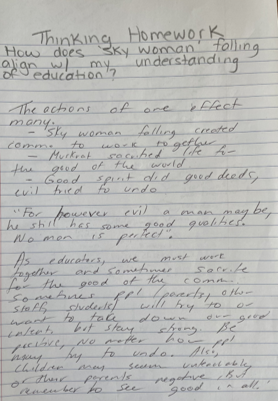The actions of one effect many. When Sky Woman fell, it created a community of beings working together to create a land in which she, and many after her, could live upon. While she rested on the back of the turtle, many animals dove down into the water to find soil to bring to the surface, but only Muskrat was successful. He sacrificed himself for the creation of Turtle Island.
After, Sky Woman gave birth to two sons, one was a good spirit, and one was evil. No matter how much good was done, evil would try to undo it, but in the end good never stopped and it prevailed.
As educators, we must work together and sometimes, we will have to sacrifice for the good of the community. We will be faced with colleagues, parents, and even students that will challenge us and bring in negativity when we are trying to shine positive lights. They will try to take down our good intentions, but we must stay strong, be positive, and do not let the darkness win. We must lean on one another for positivity, see the good in all and reflect on our selves in times of darkness.
There is light and darkness in all of us, we must accept, reflect, and reflex on our darkness to allow the light to shine.
“For however evil a man may be, he still has some good qualities. No man is perfect”.

